Overview
Signing up for Social Security Disability Benefits can feel overwhelming, but you are not alone in this journey. It’s important to understand that there is a structured process to follow.
- Determine your eligibility.
- Gather the necessary documentation.
- Complete the application.
- Be prepared to troubleshoot common issues that may arise.
This article outlines these steps in detail, emphasizing the importance of thorough preparation. Understanding the specific requirements for both Social Security Disability Insurance (SSDI) and Supplemental Security Income (SSI) is crucial. By doing so, you can increase your chances of a successful application.
We understand that navigating this process can be challenging. However, with the right information and support, you can approach it with confidence. Remember, we’re here to help you every step of the way.
Introduction
Navigating the labyrinth of Social Security Disability benefits can feel overwhelming, especially for those facing medical challenges. We understand that the intricacies of the application process are crucial, as they can significantly impact your financial stability and quality of life. This guide is here to break down the essential steps to successfully sign up for Social Security Disability benefits.
We will address common hurdles and provide clarity on eligibility criteria. With so much at stake, how can you ensure your application stands out amidst the complexities of the system? You're not alone in this journey, and we're here to help.
Understand Social Security Disability Benefits
Government assistance benefits are designed to provide financial support for individuals unable to work due to a medical condition that is expected to last at least one year or may lead to death. It is essential to understand how to sign up for social security disability, which includes knowing about the two main programs—Social Security Disability Insurance (SSDI), relying on your work history and contributions to Social Security, and Supplemental Security Income (SSI), which is need-based and does not require a work history. This knowledge significantly impacts your eligibility and the submission process.
As we look ahead to 2025, it's important to note that the Substantial Gainful Activity (SGA) threshold for SSDI is anticipated to rise, influencing who qualifies for benefits. Moreover, the maximum monthly federal SSI payout will increase from $943 in 2024 to $967 in 2025, reflecting a 2.5% cost-of-living adjustment (COLA). Currently, around 8.5 million Americans benefit from SSDI, while approximately 8 million rely on SSI. The effectiveness of these programs is illustrated through real-life stories, such as the Smith Family from Waco, TX, who expressed heartfelt gratitude upon having their SSDI case approved. Their experience underscores the transformative impact these benefits can have.
Financial advisors emphasize the importance of understanding how to sign up for social security disability, as well as the nuances of SSDI and SSI. They highlight that informed applicants are better equipped to navigate the complexities of the system and secure the support they need. Recognizing the role of medical evidence in SSDI claims is vital for a successful application. As these programs continue to evolve, staying informed about eligibility criteria and benefit calculations is essential for maximizing financial assistance. Remember, you are not alone in this journey, and we are here to help you every step of the way.
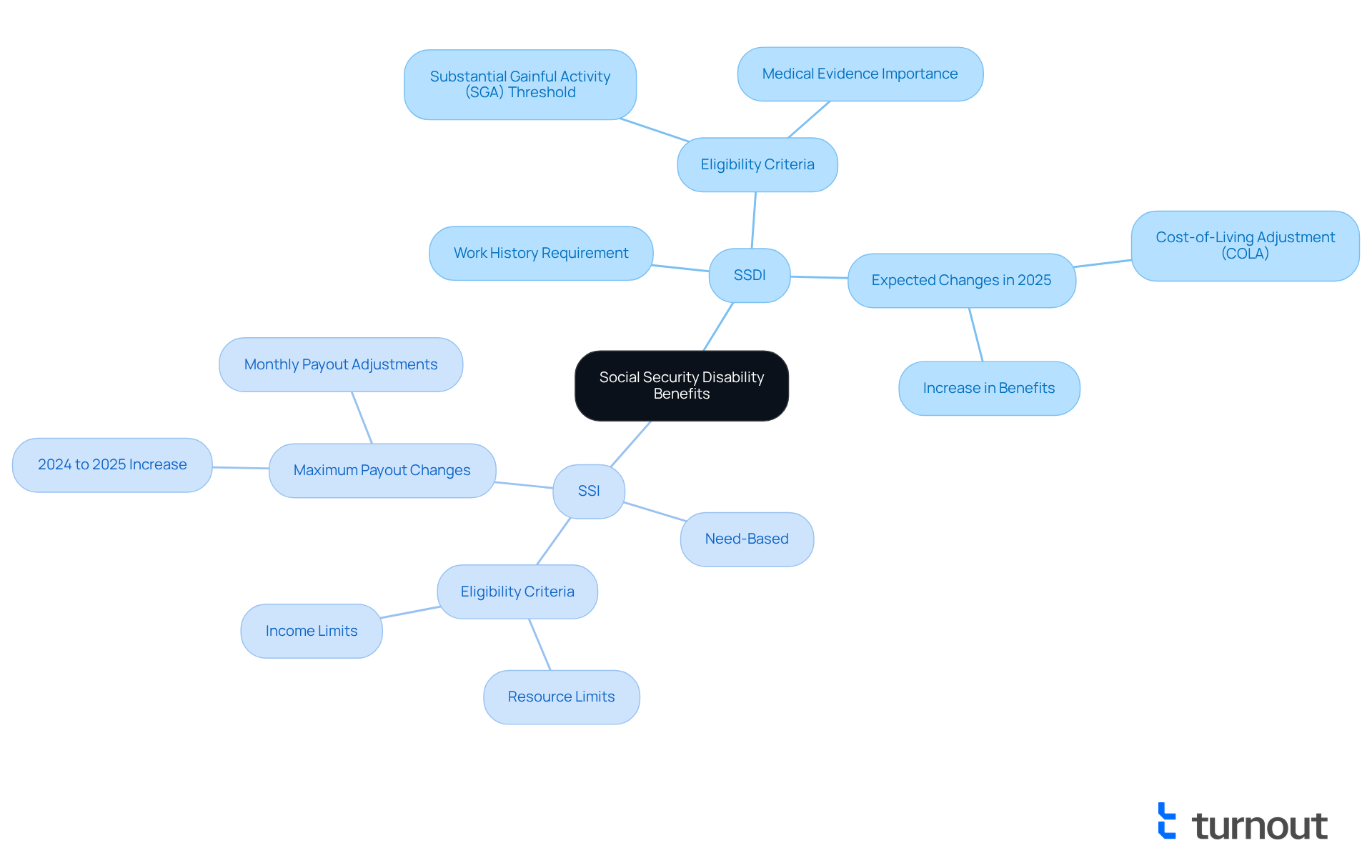
Determine Your Eligibility for Benefits
Navigating how to sign up for social security disability can feel overwhelming, but understanding the specific criteria can make a significant difference in your journey. Here’s what you need to know:
-
Work Credits: To qualify for Disability Insurance (SSDI), you generally need 40 work credits, with at least 20 earned in the last 10 years. If you are younger, you may qualify with fewer credits, recognizing that everyone has unique work histories.
-
Medical Condition: It's essential that your condition is severe enough to prevent you from engaging in any substantial gainful activity (SGA). As of 2025, the SGA limit for individuals who are not blind will be $1,620 per month. The Social Security Administration (SSA) employs a thorough five-step evaluation process to assess your disability, looking closely at your medical records and functional limitations. Even if your condition isn’t explicitly listed in the SSA's Listing of Impairments, you may still qualify for SSDI based on your functional limitations and medical evidence.
-
Income Limits: For Supplemental Security Income (SSI), your income and resources must be below certain thresholds. As of 2025, the SSI income limit for individuals is $914 per month, while couples have a limit of $1,371. These limits are critical in determining eligibility, ensuring that benefits reach those who need them most.
Starting in April 2025, the SSA will implement new identity verification methods to safeguard your Insurance records and benefits from fraud. We understand that these changes can be daunting, but knowing how to sign up for social security disability is vital for effectively navigating the application process. Consider using the SSA's eligibility tool to assess your situation—remember, you are not alone in this journey, and we're here to help.
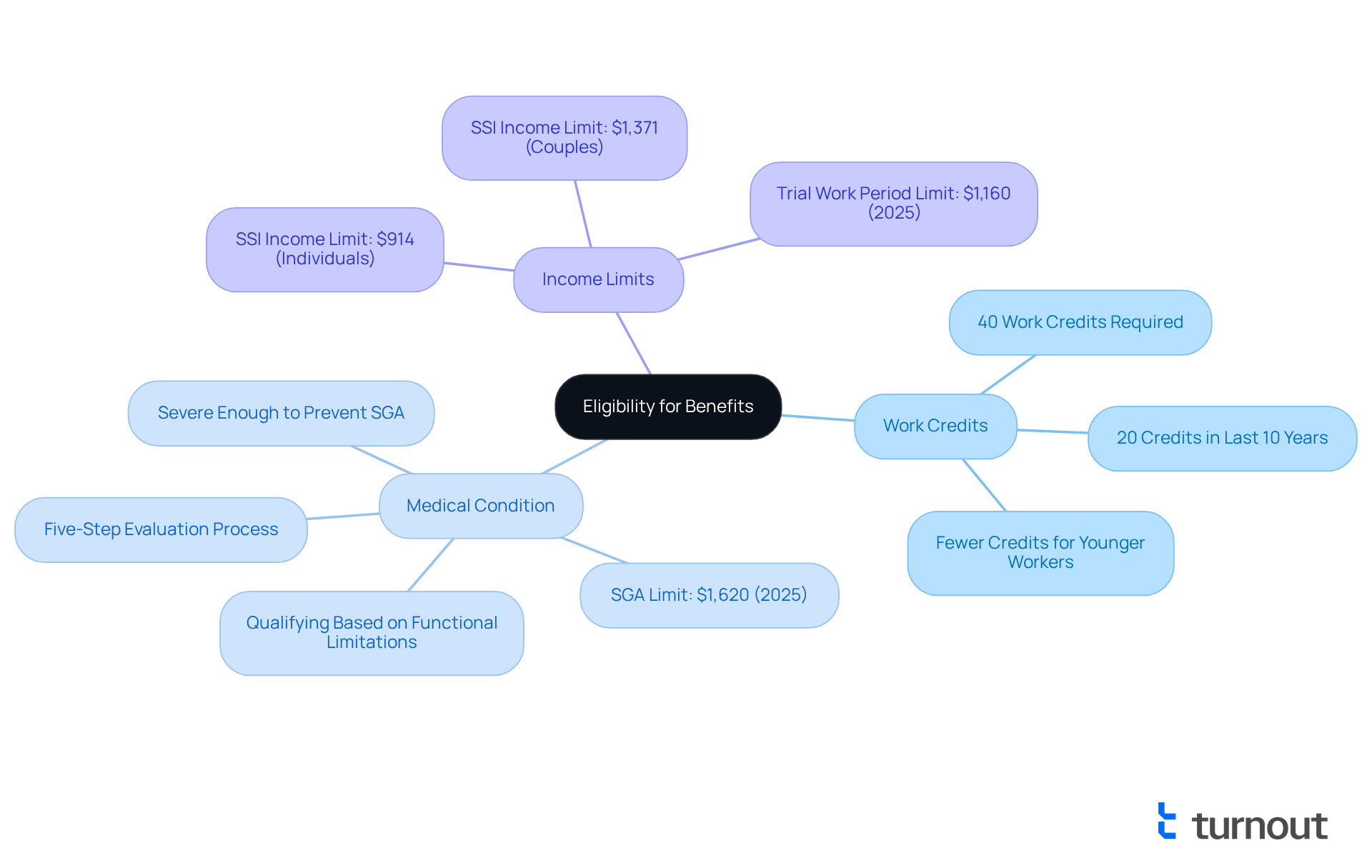
Gather Required Documentation
Before you learn how to sign up for social security disability benefits, it's important to gather a few essential documents. We understand that this process can feel overwhelming, but having the right information can make a significant difference.
- Personal Information: Start by including your Social Security number, birth certificate, and evidence of U.S. citizenship or legal residency. These documents are crucial for learning how to sign up for social security disability.
- Medical Records: Next, obtain detailed medical documentation from your healthcare providers. This should include diagnoses, treatment history, and relevant test results. These records are vital for substantiating your claim. Healthcare experts emphasize that thorough medical records greatly improve the chances of a successful submission. As one healthcare professional wisely noted, "Thorough medical documentation is key to a strong disability claim."
- Work History: Compile a comprehensive list of your jobs over the past 15 years, detailing dates of employment and job duties. This information is essential for understanding how to sign up for social security disability and demonstrating your work history and eligibility.
- Financial Information: If you're applying for Supplemental Security Income (SSI), please provide details about your income, resources, and any other benefits you receive.
Statistics show that approximately 70% of initial applications are denied due to missing documentation. This underscores the importance of thorough preparation. Real-world examples reveal that applicants who submit complete documentation are more likely to receive approval for their claims. To ensure you have all necessary items, consider consulting the SSA's Adult Impairment Starter Kit for a comprehensive checklist available on the SSA's official website.
Additionally, it's important to be aware that beginning in 2025, the income limit for retirement income subject to taxes will rise, which may affect your benefits. Remember, you're not alone in this journey; we're here to help you navigate the process.
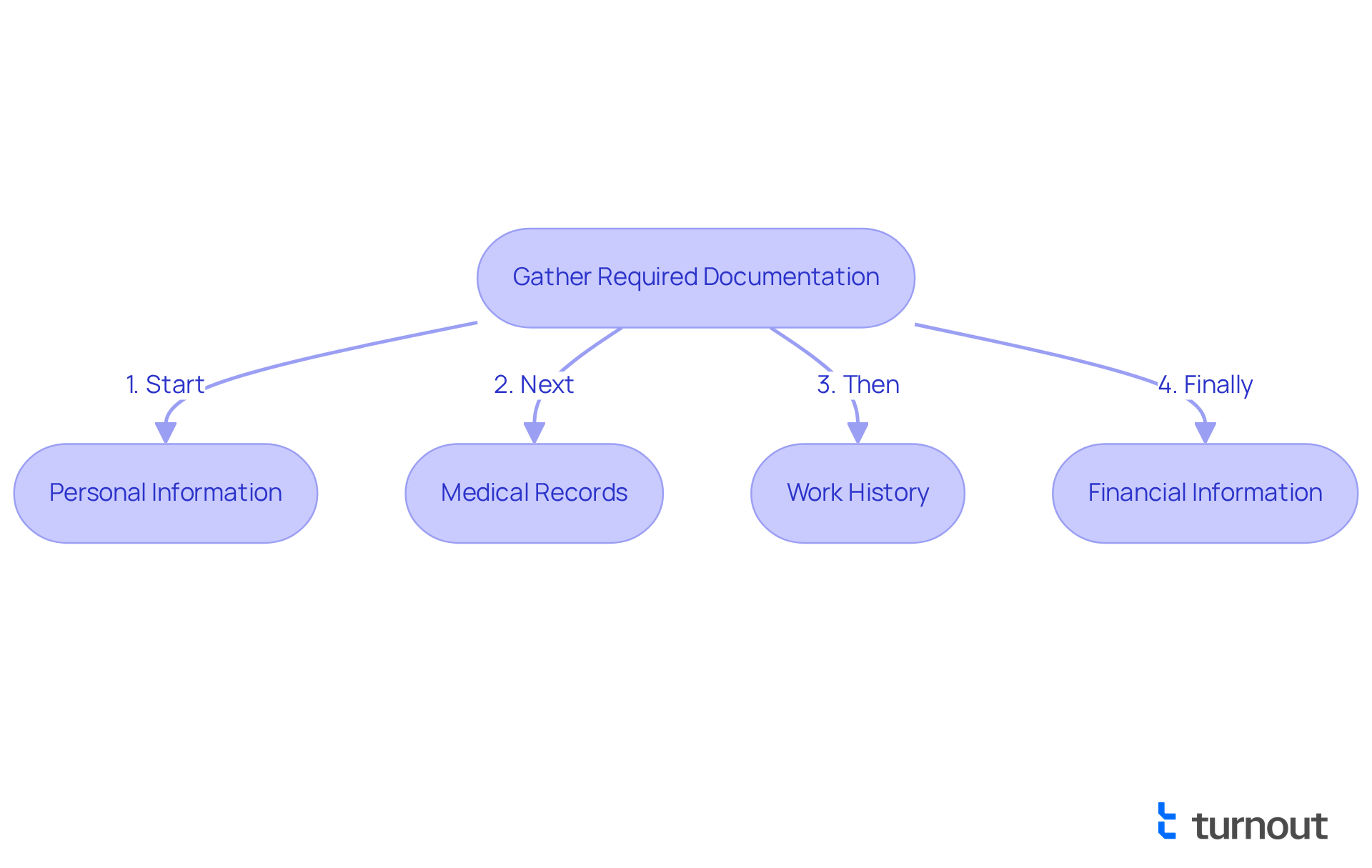
Complete the Application Process
Applying for Social Security Disability Benefits can feel overwhelming, but we're here to guide you through each step, including how to sign up for social security disability, with care and understanding. Follow these steps to make the process smoother:
-
Choose Your Application Method: You have options! Apply online at the SSA website, by phone at 1-800-772-1213, or in person at your local SSA office. Each method offers you the flexibility to select what suits you best.
-
Gather Necessary Information: Before you begin, take a moment to collect important details about your medical treatment, work history, and any other relevant facts. This preparation is crucial for a successful application and can ease your concerns.
-
Complete the Application: Fill out the Adult Impairment Report (Form SSA-16) and the Application for Insurance Benefits (Form SSA-16-BK). Ensure your responses are thorough and accurate, as this information is vital for your eligibility assessment. Keep in mind, the average completion time for the Adult Disability Report is around 90 minutes, so set aside enough time to provide detailed information.
-
Submit Your Documentation: Attach all necessary documents, including medical records and work history, to your submission. Having thorough documentation can significantly improve your chances of approval, as approximately 70% of initial SSDI and SSI requests are rejected due to inadequate information. Remember, you're not alone in this—many have faced similar challenges.
-
Review and Submit: Before sending your application, double-check for completeness and accuracy. You can save your submission online and return to it later if needed, which is especially helpful if you require more time to gather information.
Real-life experiences show that many individuals have successfully navigated the online SSDI submission process, benefiting from its convenience and accessibility. For example, applicants often report that taking the time to gather all necessary documentation upfront made a significant difference in their approval rates. We encourage you to visit the SSA's submission page for detailed instructions. Remember, you are not alone in this journey; we’re here to help you every step of the way.
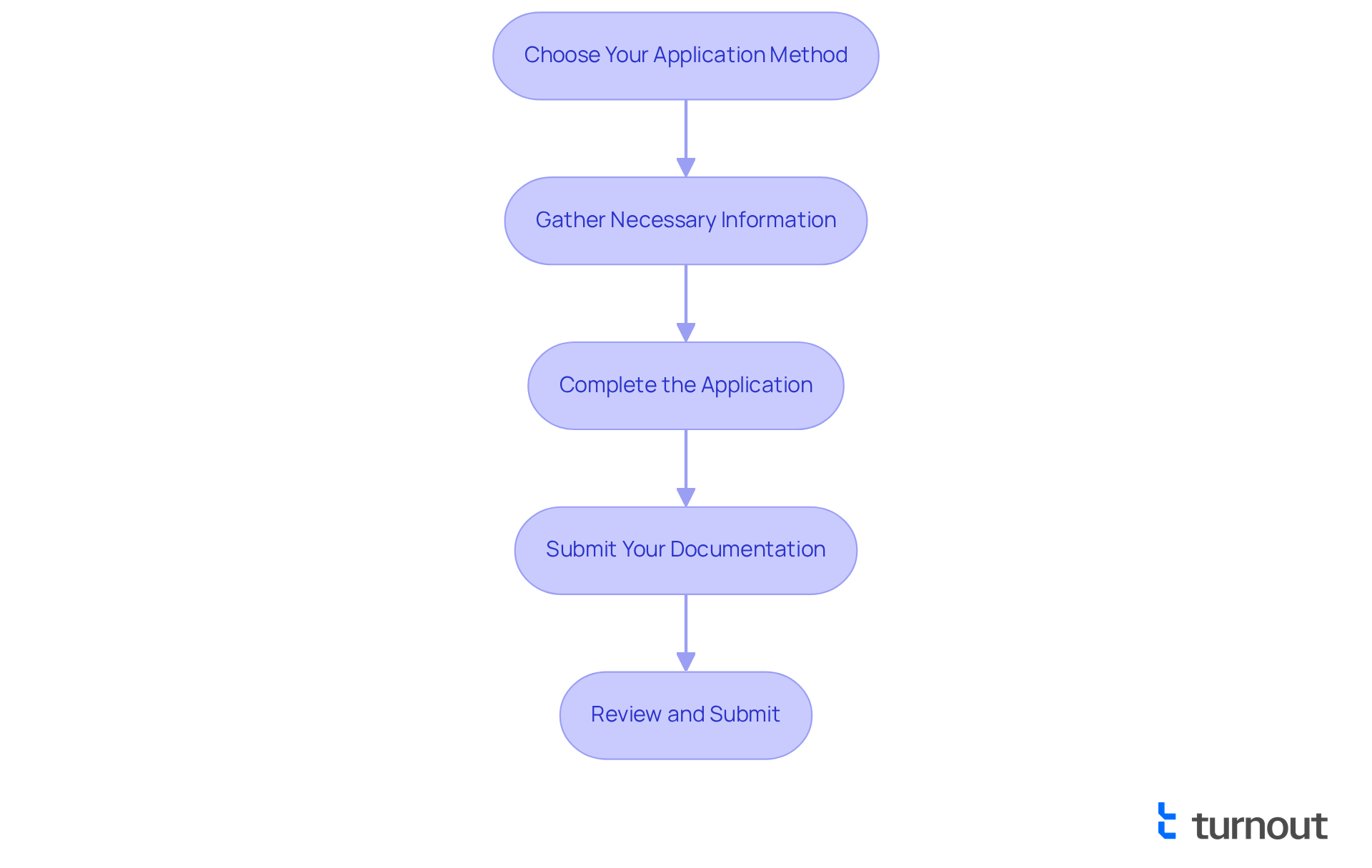
Troubleshoot Common Application Issues
Navigating the process of how to sign up for social security disability can be challenging, and many applicants encounter common issues along the way. Here’s how to troubleshoot these challenges effectively:
-
Incomplete Submissions: We understand that completing every section of your submission can feel overwhelming. However, it's crucial to ensure that all information is thoroughly provided. Missing details can significantly delay processing times, which currently average 232 days for initial decisions. Even minor omissions can lead to substantial delays in your case, so take the time to double-check your submission.
-
Insufficient Medical Evidence: If your request is denied due to a lack of medical documentation, don’t lose hope. Promptly gather additional evidence from your healthcare providers. This may include detailed statements from your treating physicians and specialists about your condition and its impact on your daily life. Many successful applicants have overcome initial denials by strengthening their medical records before reapplying, ensuring that all required forms and documentation are submitted accurately and on time.
-
Long Processing Times: It’s common to feel anxious if your request is taking longer than anticipated. Don’t hesitate to reach out to the Social Security Administration (SSA) for updates, or check your status online. With over 1 million initial claims pending as of April 2025, proactive communication is essential. Advocates often recommend following up regularly to ensure your case is progressing and to address any potential issues early.
-
Denial of Benefits: If your application is denied, remember that you have the right to appeal. Carefully follow the instructions in your denial letter to request a reconsideration. Many applicants successfully navigate the appeals process by presenting additional evidence and clarifying their eligibility under SSA rules. As one advocate noted, "We do not wait for problems to arise; we anticipate them and work proactively to prevent delays."
By addressing these common issues head-on, you can enhance your chances of understanding how to sign up for social security disability benefits you deserve. Remember, you are not alone in this journey; we’re here to help you every step of the way.
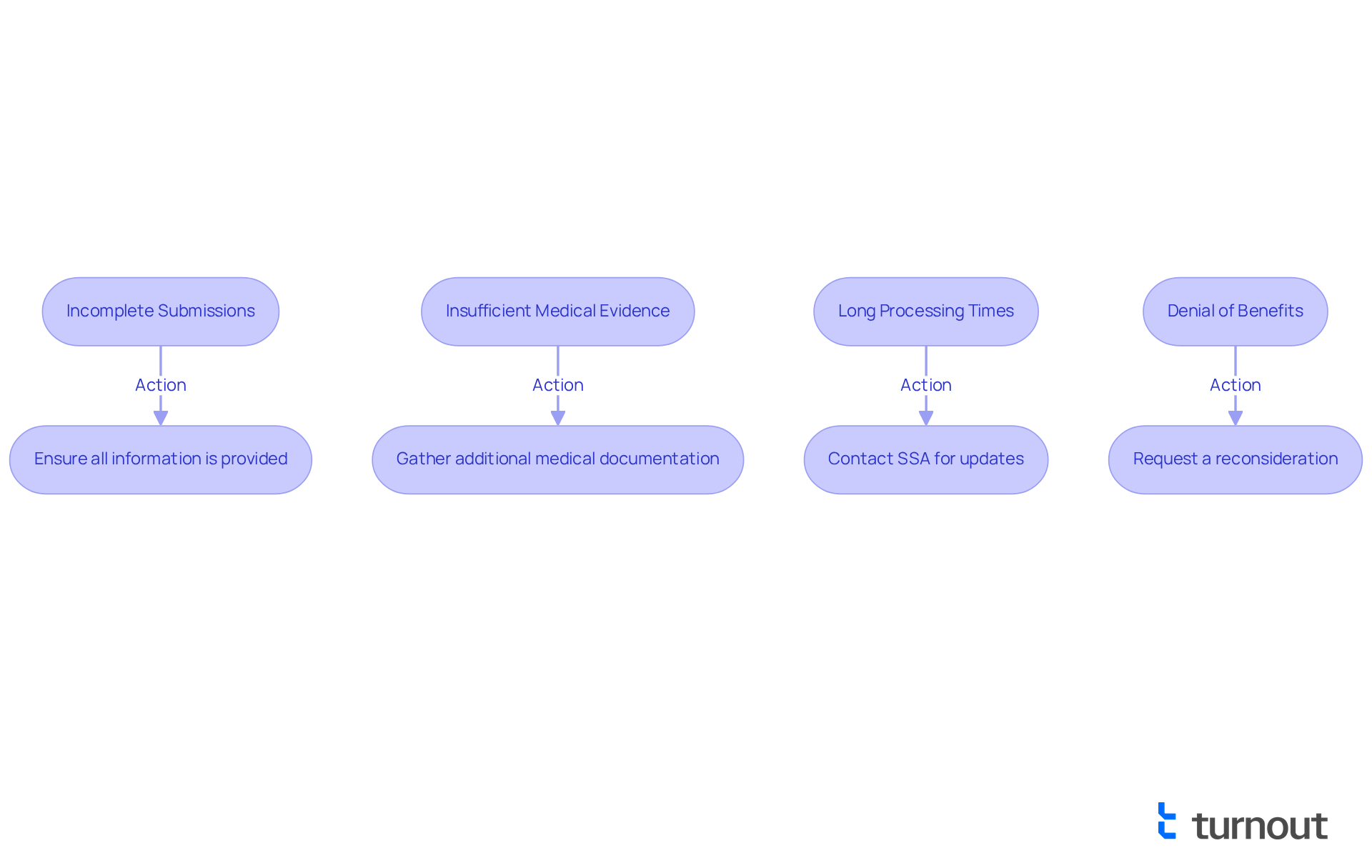
Conclusion
Navigating the process of signing up for social security disability benefits can feel overwhelming. However, breaking it down into manageable steps can empower you to tackle this journey successfully. It's essential to be informed and prepared, as this knowledge can greatly enhance your chances of receiving the support you need during difficult times.
Key points to consider include:
- Understanding the difference between SSDI and SSI
- Knowing the eligibility criteria based on your work history and medical conditions
- The importance of gathering thorough documentation
- Understanding the application process
- Troubleshooting common issues
- Staying proactive
Real-life examples show that with careful preparation and attention to detail, successful outcomes are possible.
Remember, you don't have to face the journey to obtaining social security disability benefits alone. By utilizing available resources, staying updated on changes in eligibility criteria, and seeking help when necessary, you can navigate this complex system more effectively. Taking that first step towards understanding and applying for these benefits can lead to transformative support, ensuring that you receive the financial assistance you need and deserve.
Frequently Asked Questions
What are Social Security Disability Benefits?
Social Security Disability Benefits are government assistance programs designed to provide financial support for individuals who are unable to work due to a medical condition expected to last at least one year or may lead to death.
What are the two main programs under Social Security Disability?
The two main programs are Social Security Disability Insurance (SSDI), which relies on your work history and contributions to Social Security, and Supplemental Security Income (SSI), which is need-based and does not require a work history.
How does the Substantial Gainful Activity (SGA) threshold affect SSDI eligibility?
The SGA threshold for SSDI is anticipated to rise in 2025, which will influence who qualifies for benefits by determining the maximum amount an individual can earn while still being eligible for SSDI.
What will be the maximum monthly federal SSI payout in 2025?
The maximum monthly federal SSI payout will increase from $943 in 2024 to $967 in 2025, reflecting a 2.5% cost-of-living adjustment (COLA).
How many Americans currently benefit from SSDI and SSI?
Approximately 8.5 million Americans benefit from SSDI, while around 8 million rely on SSI.
What are the eligibility criteria for SSDI?
To qualify for SSDI, you generally need 40 work credits, with at least 20 earned in the last 10 years. Younger individuals may qualify with fewer credits.
What is the SGA limit for individuals who are not blind in 2025?
The SGA limit for individuals who are not blind will be $1,620 per month in 2025.
How does the Social Security Administration evaluate disability claims?
The SSA uses a five-step evaluation process to assess disabilities, examining medical records and functional limitations to determine eligibility.
What are the income limits for SSI eligibility in 2025?
For SSI, the income limit for individuals is $914 per month, while for couples, the limit is $1,371.
What new measures will the SSA implement in April 2025?
Starting in April 2025, the SSA will implement new identity verification methods to protect Insurance records and benefits from fraud.




